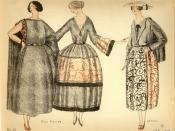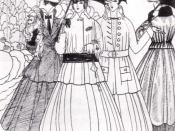Haute Couture Designer - Jeanne Lanvin
Today, Alber Elbaz performs an incredible task as "head of Lanvin," however, the legacy entirely began with "Jeanne Lanvin, the founder of the House of Lanvin, and great dame who was considered one of the most influential designers of the 20th century" (Menkes). Jeanne Lanvin was "born in Paris on 1 January, 1867 to Constantin Lanvin and Sophie White. The eldest of 11 children, she became an apprentice milliner at Madame Félix in Paris at the age of 16, and trained as a dressmaker at a Talbot before becoming a milliner on the rue du Faubourg Saint-Honoré in 1889" (Aillaud). The designer wed an Italian aristocrat, "Count Emilio di Pietro in 1895, and gave birth to her daughter, Marguerite two years later." The couple later split, but Lanvin remarried journalist, Xavir Melet in 1907 (Menkes).
In 1909, "Lanvin joined the Syndicat de la Couture, which marked her formal status as a couturière" of Haute Couture.
Now a devoted parent, Lanvin also designed "an extensive wardrobe for her daughter, Marguerite Marie-Blanche who was the inspiration and muse behind her designs" (Kirke & Mallett). These designs appealed to many affluent folks who requested replicas for their kids. In an attempt to satisfy demand for adult adaptations of her children's garments, Lanvin began creating lines for women and girls, and later opened a Haute Couture portion of House of Lanvin, retailing premium mother/daughter garments (Menkes).
Influenced by Orientals, Lanvin created "exotic evening wear in Eastern-style velvets and satins" around 1914. In 1919, as World War I came to an end, Lanvin launched "Wartime Crinoline," a transition from Paul Poiret's Hobble skirt several years earlier, but as the 1920's approached, dance became the rage, so clothing became shorter, and a flat-chest silhouette was popularized.


